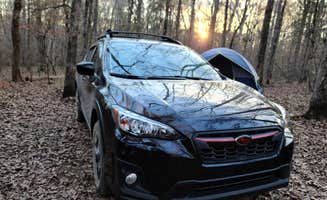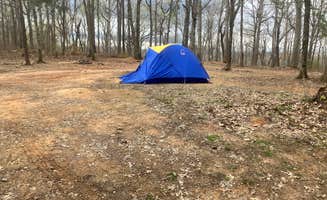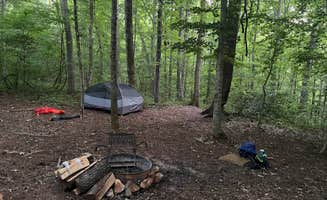Uwharrie National Forest dispersed camping options vary by seasonal conditions and vehicle requirements. Primitive camping areas throughout the forest have increased in popularity, particularly for backcountry enthusiasts seeking solitude. The area features low-elevation terrain averaging 500-700 feet above sea level, with creeks prone to seasonal flooding after heavy rains.
What to do
Off-road exploration: Uwharrie offers extensive OHV trails for 4WD vehicles. According to one visitor at Uwharrie National Forest, "We also took our Jeep on the OHV trails and had a blast. There are several places you can take a canoe or kayak on and the scenery on the lake was beautiful as well."
Creek hiking: Multiple streams cross the wilderness areas, providing natural navigation landmarks. A camper at Birkhead Mountain Wilderness Area Dispersed noted, "Very nice trails. Well maintained. Not marked the best... signs at intersections. Plenty of creeks. Hike in for dispersed camping."
Kayaking access: The Little River area provides water-based entry points to more remote camping areas. Visitors often use the boat ramp where Pekin Road crosses the Little River to begin their journey into secluded camping spots.
Wildlife observation: Fall and winter seasons offer improved visibility through the forest. One regular visitor mentioned, "This area was a place that I went often to deer hunt in the fall. I have never came across another camper/hunter at this location. It is a good location if you are looking for an area that is away from camp grounds and heavy traffic."
What campers like
Privacy between sites: The dispersed camping areas provide sufficient space between campers. A visitor to Dispersed Camping off Falls Dam Trail appreciated that they "enjoyed the song of wind and birds" during their stay, suggesting a peaceful environment.
Natural water sources: Most primitive sites are situated near streams for water access. Along the Uwharrie Trail, one camper mentioned, "Water available on both sides of camp / trail," making it convenient for filtering drinking water during longer stays.
Established fire rings: Many primitive sites feature stone fire rings from previous campers. As one visitor noted, "Most sites have rock fire pits and room to set up. Love it here. Plenty of OHV trails as well."
Trail connectivity: The camping areas connect to multiple trail networks. One backpacker explained, "The Uwharrie Trail, which pretty much spans the park north/south is about 20 miles point to point. The trailhead is kind of hard to follow sometimes, sections of the trail are prone to flooding and creek crossings can become difficult following heavy rains."
What you should know
Vehicle requirements: Many rustic camping near Seagrove requires appropriate transportation. According to one camper, "This is a great area for dispersed campers with 4WD or AWD. It's pretty popular so head out early to secure your spot."
Trail marking limitations: Navigation can be challenging in some areas. A hiker at Shallow Ford Natural Area shared, "This campsite is on the Mountains to Sea Trail for those that are doing that. There's lots of shade and it is very peaceful. It is pretty flat for your tent and there are fire rings."
Seasonal flooding: Water crossings can become impassable after heavy rain. One experienced backpacker noted, "The trailhead is kind of hard to follow sometimes, sections of the trail are prone to flooding and creek crossings can become difficult following heavy rains."
Hunting awareness: Wilderness camping near Seagrove coincides with hunting seasons. Campers should "Wear bright colors during hunting season because there are a ton of people out deer hunting in this area."
Tips for camping with families
Site selection priorities: For family camping trips, prioritize sites with level ground and nearby water. A camper observed, "The tent sites nice and clean and level. The host drove through many many times in the 3 days I was there."
Pack appropriate filtration: Since primitive camping areas lack potable water, families should bring proper filtration systems. One backpacker advised, "The streams, provided one has filtration or iodine tablets, provide ample sources of drinking water."
Camp cleanliness: Teaching leave-no-trace principles is essential in these areas. A visitor noted, "Some of the sites may have a little trash left from the last user, so please try to leave it cleaner than you came to."
Tips from RVers
Generator usage: RV camping in primitive areas often requires generators for power. One camper at Uwharrie National Forest mentioned, "We used our pop-up with a generator in rustic locations. There are hiking, horse, OHV, dirt bike, ATV, and mountain bike trails."
Limited facilities: Be prepared for truly self-contained camping. A visitor pointed out, "No toilets for dispersed areas. Most sites have rock fire pits and room to set up."
Campsite timing: Arrive early to secure suitable RV sites, especially during peak seasons. One camper recommended, "It's pretty popular so head out early to secure your spot."




